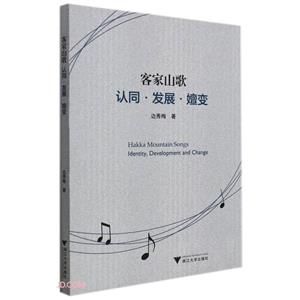-
>
浮世三千景 浮世绘艺术精选集
-
>
中国美术8000年
-
>
西洋镜--中国寺庙建筑与灵岩寺罗汉
-
>
和光同尘:徐家树摄影集(普通版)
-
>
航拍广州
-
>
(精)如何用手机拍一部电影(八品)
-
>
银翼杀手2029
客家山歌:认同·发展·嬗变:identity, development and change 版权信息
- ISBN:9787308217972
- 条形码:9787308217972 ; 978-7-308-21797-2
- 装帧:一般胶版纸
- 册数:暂无
- 重量:暂无
- 所属分类:>>
客家山歌:认同·发展·嬗变:identity, development and change 内容简介
客家山歌是客家人在山野间用客家话即兴演唱的口头文学,是中国重要的民间音乐文化,于2006年入选**批国家非物质文化遗产名录。尽管在当地客家山歌独有的艺术特色被大家所广泛接收,但随着文化全球化时代的到来,客家人现代生活方式的改变、媒介技术的革新以及不同文化之间的碰撞与交流,从现今发展情况来看客家山歌已处于下滑之势,其传承与发展工作迫在眉睫。本书通过对客家山歌的认同、发展和变化进行研究,其目的在于:1)探讨客家山歌形成的认同的重要因素;2)探讨社会变迁与客家山歌的关系;3)探讨现代社会客家山歌的保护方式和发展策略。
客家山歌:认同·发展·嬗变:identity, development and change 目录
1.1 Background and rationale
1.1.1 Foreign research status
1.1.2 Research status in China
1.2 Objectives of the study
1.3 Research questions
1.4 Definition of terms
1.4.1 Hakka mountain songs
1.4.2 Identity
1.4.3 Development
1.4.4 Change
1.5 Scope of the study
1.6 Significance of the study
1.7 Conceptual framework
1.8 Outline of the study
CHAPTER 2 Research Methodology
2.1 Research design
2.1.1 Literature review method
2.1.2 Fieldwork
2.1.3 Observation method
2.2 Data collection
2.3 Data analysis
2.3.1 Literature analysis
2.3.2 Comparative analysis
2.3.3 Music analysis
CHAPTER 3 Hakka Music Culture
3.1 The historical origin of Hakka music culture
3.1.1 Hakka music culture in ancient times
3.1.2 Hakka music culture from 1930 to 1978
3.1.3 Hakka music culture after Chinese reform and opening-up (after 1978)
3.2 The classification of Hakka music culture
3.2.1 Hakka traditional songs
3.2.2 Hakka instrumental music
3.2.3 Hakka song and dance
3.2.4 Hakka opera
3.2.5 Hakka rap art
3.3 The characteristic of Hakka music culture
3.3.1 The integration of Hakka music culture
3.3.2 The rationality of Hakka music culture
3.3.3 Openness and inclusiveness of Hakka music culture
3.4 Ecological environment of Hakka music culture
3.4.1 Natural ecology
3.4.2 Social ecology
CHAPTER 4 The Identity of I-Iakka Mountain Songs
4.1 The historical origin of Hakka mountain songs
4.1.1 Formation of Hakka mountain songs
4.1.2 Historical changes of Hakka mountain songs
4.2 The classification of Hakka mountain songs
4.2.1 Love songs
4.2.2 Production and life mountain songs
4.2.3 Current political mountain songs
4.2.4 Folklore mountain songs
4.2.5 Special forms of mountain songs
4.3 Musical morphological feature of Hakka mountain songs
4.3.1 Meters characteristics of Hakka mountain songs
4.3.2 Rhythm characteristics of Hakka mountain songs
4.3.3 Scale characteristics of Hakka mountain songs
4.4 Language features of Hakka mountain songs
4.4.1 The language features of life and visualization
4.4.2 The application of mood tone words
4.4.3 The use of rhetorical devices in Hakka mountain songs
4.5 Characteristics of accompaniment of Hakka mountain songs
4.5.1 Characteristics of accompaniment of Xingguo Hakka mountain songs
4.5.2 Characteristics of accompaniment of Meizhou Hakka mountain songs
4.6 Singing forms of Hakka mountain songs
4.6.1 Solo singing
4.6.2 Duet singing
4.6.3 Mountain song battle on the platform
4.6.4 Group singing and performing of mountain songs
4.7 Functions of Hakka mountain songs
4.7.1 Entertaining and communicative functions
4.7.2 Publicity and educational functions
4.7.3 Religious and cultural inheritance functions
CHAPTER 5 Investigation on the Present Situation of Hakka Mountain Songs
5.1 An analysis of the present situation of the spread and development of Hakka mountain songs
5.1.1 Disseminator
5.1.2 Dissemination content
5.1.3 Dissemination channel
5.1.4 Audience of communication
5.1.5 Communication effect
5.2 An analysis of the causes of the development and decline of Hakka mountain songs
5.2.1 Internal reasons
5.2.2 External reasons
CHAPTER 6 Measures and Paths of Inheriting and Developing Hakka Mountain Songs
6.1 Give full play to the main role of the government
6.1.1 Strengthening the funding budget and expanding the sources of funds
6.1.2 Establishing and improving the protection mechanism and management system of Hakka mountain songs
6.1.3 Constructing the protection, cultivation and inheritance system of Hakka mountain song inheritors
6.2 Developing the m
客家山歌:认同·发展·嬗变:identity, development and change 作者简介
边秀梅,博士,湖州师范学院艺术学院副教授,湖州市南太湖高端文化人才,泰国孔敬大学高级访问学者,中国艺术人类学学会会员,长期从事音乐人类学、声乐演唱与教学及音乐教育的研究。近年来主持和参与完成国家社科基金项目、全国教育技术研究规划课题等***、省部级课题8项。以第一作者在Journal of Music and Performing Arts、Journal of Fine and Applied Arts、《音乐创作》《学术交流》《中国电化教育》等期刊发表学术论文20余篇。从教20年来指导学生在各类比赛中获奖。
- >
我与地坛
我与地坛
¥16.5¥28.0 - >
罗庸西南联大授课录
罗庸西南联大授课录
¥13.8¥32.0 - >
罗曼·罗兰读书随笔-精装
罗曼·罗兰读书随笔-精装
¥20.3¥58.0 - >
有舍有得是人生
有舍有得是人生
¥17.1¥45.0 - >
苦雨斋序跋文-周作人自编集
苦雨斋序跋文-周作人自编集
¥5.8¥16.0 - >
二体千字文
二体千字文
¥22.4¥40.0 - >
巴金-再思录
巴金-再思录
¥14.7¥46.0 - >
伯纳黛特,你要去哪(2021新版)
伯纳黛特,你要去哪(2021新版)
¥15.9¥49.8
-
说乐:65篇音乐杂文散文
¥16.4¥45 -
交响曲的声音
¥38.8¥88 -
音乐的伤痛
¥14.4¥38 -
诸子论音乐:中国音乐美学名著导读
¥14.9¥38 -
中国民族民间音乐的历史传承与发展
¥39.2¥78 -
圆舞曲艺术
¥10.4¥29





















